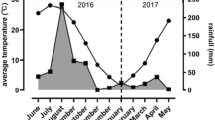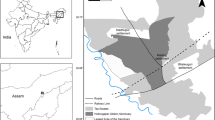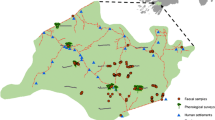Abstract
Knowledge about the feeding ecology and dietary overlap of sympatric primates is essential for understanding how animals avoid or reduce interspecific competition. From April 2014 to March 2015, we investigated the feeding ecologies of two sympatric primates, a hindgut fermenter, the long-tailed macaque (Macaca fascicularis) and a foregut fermenter, the dusky langur (Trachypithecus obscurus obscurus), in a mixed landscape consisting of urban and agro-forested areas and forest fragments in Malaysia. We collected a total of 5570 and 4029 of feeding records for M. fascicularis and T. o. obscurus, respectively, using the 10-min scan sampling method. Food availability and seasonal changes in plant species consumed by both study groups were determined by vegetation surveys carried out across an area of 1.6 ha. A total of 113 and 130 plant species were consumed by M. fascicularis and T. o. obscurus, respectively. Leaves (51%) and fruits (40%) accounted for the majority of the feeding records in T. o. obscurus, whereas fruits (32%) and anthropogenic foods (27%) together with leaves (15%) and insects (6%) accounted for the majority of the feeding records for M. fascicularis. Throughout the year, there were 59 consumed plant species common to both species, and the dietary overlap was the highest for fruits. Although leaves were always more abundant than fruits in our study site, the amount of monthly fruit eating by the two species showed a significant correlation with that of fruit availability. Monthly fruit availability had a positive effect on overall monthly dietary overlap while flower and leaf availability had a negative effect. We showed that fruit was the preferred food resource of two sympatric species with different digestive systems. This could have implications for resource competition, interspecific competition, and niche separation, which should be investigated in more detail.






Similar content being viewed by others
References
Aldrich-Blake FPG (1980) Long-tailed macaques. In: Chivers DJ (ed) Malayan forest primates. Springer, New York, pp 147–166
Amato KR, Metcalf JL, Song SJ, Hale VL, Clayton J, Ackermann G, Humphrey G, Niu K, Cui D, Zhao H, Schrenzel MD, Tan CL, Knight R, Braun J (2016) Using the gut microbiota as a novel tool for examining colobine primate GI health. Global Ecology and Conservation 7:225–237
Altmann J (1974) Observational study of behavior: sampling methods. Behaviour 49:227–266
Bartoń K (2013) MuMIn: Multi-model inference. R package version 1.9.0. http://CRAN.R-project.org/package
Brotcorne F (2014) Behavioral ecology of commensal long-tailed macaque (Macaca fascicularis) populations in Bali, Indonesia. PhD Dissertation, University of Liege, Liege
Burnham KP, Anderson DR (2002) Model selection and multimodel inference: a practical information-theoretic approach. Springer, New York
Chivers DJ (1994) Functional anatomy of the gastrointestinal tract. In: Davies A, Oates J (eds) Colobine monkeys: their ecology, behaviour and evolution. Cambridge University Press, Cambridge, pp 205–227
Collins L, Roberts M (1978) Arboreal folivores in captivity-maintenance of a delicate minority. In: Montgomery GG (ed) The ecology of arboreal folivores. Smithsonian Institution Press, Washington, pp 5–12
Curtin SH (1980) Dusky and banded leaf monkeys. In: Chivers DJ (ed) Malayan forest primates. Springer, Boston, pp 107–146
Danish L, Chapman CA, Hall MB, Rode KD, O’Driscoll Worman C (2006) The role of sugar in diet selection in redtail and red colobus monkeys. In: Hohmann G, Robbins MM, Boesch C (eds) Feeding ecology in apes and other primates. Cambridge University Press, Cambridge, pp 473–487
Davies G (1991) Seed-eating by red leaf monkeys (Presbytis rubicunda) in dipterocarp forest of northern Borneo. Int J Primatol 12:119–144
Davies G, Oates J (1994) Colobine monkeys: their ecology, Behaviour and Evolution. Cambridge University Press, Cambridge
Dela JDS (2007) Seasonal food use strategies of Semnopithecus vetulus nestor, at Panadura and Piliyandala, Sri Lanka. Int J Primatol 28:607–626
Dela JDS (2012) Western purple-faced langurs (Semnopithecus vetulus nestor) feed on ripe and ripening fruits in human-modified environments in Sri Lanka. Int J Primatol 33:40–72
Ehlers Smith DA, Husson SJ, Ehlers Smith YC, Harrison ME (2013) Feeding ecology of red langurs in Sabangau tropical peat-swamp forest, Indonesian Borneo: extreme granivory in a non-masting forest. Am J Primatol 75:848–859
Fashing PJ (2001) Feeding ecology of guerezas in the Kakamega Forest, Kenya: the importance of Moraceae fruit in their diet. Int J Primatol 22:579–609
Fleagle JG, Janson CH, Reed KE (1999) Primate communities. Cambridge University Press, Cambridge
Forthman-Quick DL, Demment M (1988) Dynamics of exploitation: differential energetic adaptations of two troops of baboons to recent human contact. In: Fa JE, Southwick CH (eds) Ecology and behaviour of food enhanced primate groups. AR Liss, New York, pp 25–51
Gumert M, Jones-Engel L, Fuentes A (2011) The common monkey of Southeast Asia: long-tailed macaque populations, ethnophoresy, and their occurrence in human environments. In: Fuentes A, Gumert M, Jones-Engel L (eds) Monkeys on the edge: ecology and management of long-tailed Macaques and their interface with humans. Cambridge University Press, New York, pp 3–44
Hadi S, Ziegler T, Waltert M, Syamsuri F, Mühlenberg M, Hodges JK (2012) Habitat use and trophic niche overlap of two sympatric colobines, Presbytis potenziani and Simias concolor, on Siberut Island, Indonesia. Int J Primatol 33:218–232
Hanya G, Bernard H (2012) Fallback foods of Red Leaf Monkeys (Presbytis rubicunda) in Danum Valley, Borneo. Int J Primatol 33:322–337
Hanya G, Bernard H (2015) Different roles of seeds and young leaves in the diet of Red Leaf Monkeys (Presbytis rubicunda): comparisons of availability, nutritional properties, and associated feeding behavior. Int J Primatol 36:177–193
Hayakawa T, Nathan S, Stark DJ, Saldivar DAR, Sipangkui R, Goossens B, Tuuga A, Clauss M, Sawada A, Fukuda S, Imai H, Matsuda I (2018) First report of foregut microbial community in proboscis monkeys: are diverse forests a reservoir for diverse microbiomes? Environ Microbiol Rep. https://doi.org/10.1111/1758-2229.12677
Holmes RT, Pitelka FA (1968) Food overlap among coexisting sandpipers on northern Alaskan tundra. Syst Zool 17:305–318
Idilfitri S, Mohamad NHN (2012) Role of ornamental vegetation for birds’ habitats in urban parks: case study FRIM, Malaysia. Procedia Soc Behav Sci 68:894–909
Johnson JB, Omland KS (2004) Model selection in ecology and evolution. Trends Ecol Evol 19:101–108
Kay RNB, Davies AG (1994) Digestive physiology. In: Davies G, Oates J (eds) Colobine monkeys: their ecology, behaviour and evolution. Cambridge University Press, Cambridge, pp 229–249
Kirkpatrick RC (1999) Colobine diet and social organization. In: Dolhinow P, Fuentes A (eds) The non-human primates. Mayfield, Palo Alto, pp 93–105
Koenig A, Borries C (2001) Socioecology of Hanuman langurs: the story of their success. Evol Anth 10:122–137
Koenig A, Beise J, Chalise MK, Ganzhorn JU (1998) When females should contest for food-testing hypotheses about resource density, distribution, size, and quality with Hanuman langurs (Presbytis entellus). Behav Ecol Sociobiol 42:225–237
Kool KM (1993) The diet and feeding behavior of the silver leaf monkey (Trachypithecus auratus sondaicus) in Indonesia. Int J Primatol 14:667–700
Lucas PW, Corlett RT (1991) Relationship between the diet of Macaca fascicularis and forest phenology. Folia Primatol 57:201–215
MacKinnon JR, MacKinnon KS (1980) Niche differentiation in a primate community. In: Chivers DJ (ed) Malayan forest primates. Springer, New York, pp 167–190
Mat Salleh K (1999) The role and function of Universiti Kebangsaan Malaysia permanent forest reserve in research and education. Pertanika J Trop Agric Sci 22:185–198
Matsuda I, Tuuga A, Higashi S (2009) The feeding ecology and activity budget of proboscis monkeys. Am J Primatol 492:478–492
Matsuda I, Otani Y, Bernard H, Wong A, Tuuga A (2016) Primate survey in a Bornean flooded forest: evaluation of best approach and best timing. Mammal Study 41:101–106
Matsuda I, Clauss M, Tuuga A, Sugau J, Hanya G, Yumoto T, Bernard H, Hummel J (2017) Factors affecting leaf selection by foregut-fermenting proboscis monkeys: new insight from in vitro digestibility and toughness of leaves. Sci Rep 7:42774
Md-Zain BM, Abdullah M (2008) Primat Bukit Belata. In: Muda A, Koh HL, Mustafa NM, Mustafa SN, Nawi SA, Latiff A (eds) Bukit Belata, Selangor: Pengurusan Persekitaran Fizikal, Kepelbagaian Biologi dan Sosio-ekonomi. Jabatan Perhutanan Semenanjung Malaysia, Kuala Lumpur, pp 270–273
Md-Zain BM, Ch’ng CE (2011) The activity patterns of a group of Cantor’s dusky leaf monkeys (Trachypithecus obscurus halonifer). Int J Zool Res 7:59–67
Md-Zain BM, Shaari NA, Mohd-Zaki M, Ruslin F, Idris NI, Kadderi MD, Idris WMR (2010) A comprehensive population survey and daily activity budget on long tailed macaques of Universiti Kebangsaan Malaysia. J Biol Sci 10(7):608–615
Md-Zain BM, Tarmizi MR, Zaki MM (2011) Campus monkeys of Universiti Kebangsaan Malaysia: nuisance problems and students’ perception. In: Fuentes A, Gumert M, Jones-Engel L (eds) Monkeys on the edge: ecology and management of long-tailed macaques and their interface with humans. Cambridge University Press, New York, pp 101–119
Reed KE, Bidner LR (2004) Primate communities: past, present, and possible future. Yearb Phys Anthropol 47:2–39
Sha JCM, Hanya G (2013a) Temporal food resource correlates to the behavior and ecology of food-enhanced long-tailed macaques (Macaca fascicularis). Mamm Study 38:163–175
Sha JCM, Hanya G (2013b) Diet, activity, habitat use, and ranging of two neighboring groups of food-enhanced long-tailed macaques (Macaca fascicularis). Am J Primatol 75:581–592
Singh M, Roy K, Singh M (2011) Resource partitioning in sympatric langurs and macaques in tropical rainforests of the central Western Ghats, south India. Am J Primatol 73:335–346
Strum SC (2010) The development of primate raiding: implications for management and conservation. Int J Primatol 31:133–156
Ungar PS (1995) Fruit preferences of four sympatric primate species at Ketambe, northern Sumatra, Indonesia. Int J Primatol 16:221–245
Vandercone RP, Dinadh C, Wijethunga G, Ranawana K, Rasmussen DT (2012) Dietary diversity and food selection in Hanuman langurs (Semnopithecus entellus) and purple-faced langurs (Trachypithecus vetulus) in the Kaludiyapokuna forest reserve in the dry zone of Sri Lanka. Int J Primatol 33:1382–1405
Acknowledgements
The authors acknowledge Universiti Kebangsaan Malaysia and Department of Wildlife and National Parks, Malaysia Peninsula, for providing necessary funding, facilities, and assistance. The research was conducted under research permit approved by Department of Wildlife and National Parks, Malaysia Peninsula (JPHL&TN(IP):100-34/1.24 Jld 9 (40). We thank Ahmad Fitri Zohari for plant species identification. This research was supported by Grants AP-2015-004, FRGS/1/2012/STWN10/UKM/02/3, TD-2014-022, and DLP-2013-006. This study was also partly financed by Grant-in-Aid for Young Scientists (A) (26711027 to IM), JSPS Core-to-Core Program, Advanced Research Networks (to S. Koshima), and the Cooperative Research Program by KUPRI (2016-B-98 to FR). Finally, we thank Goro Hanya and John C.M. Sha for their helpful suggestions and comments on an earlier draft of this manuscript.
Author information
Authors and Affiliations
Corresponding author
Electronic supplementary material
Below is the link to the electronic supplementary material.
10329_2018_705_MOESM1_ESM.docx
Appendix I: Food items and parts of each item consumed by M. fascicularis from April 2014 to March 2015. Appendix II: Food items and parts of each item consumed by T. o. obscurus from April 2014 to March 2015
About this article
Cite this article
Ruslin, F., Matsuda, I. & Md-Zain, B.M. The feeding ecology and dietary overlap in two sympatric primate species, the long-tailed macaque (Macaca fascicularis) and dusky langur (Trachypithecus obscurus obscurus), in Malaysia. Primates 60, 41–50 (2019). https://doi.org/10.1007/s10329-018-00705-w
Received:
Accepted:
Published:
Issue Date:
DOI: https://doi.org/10.1007/s10329-018-00705-w




